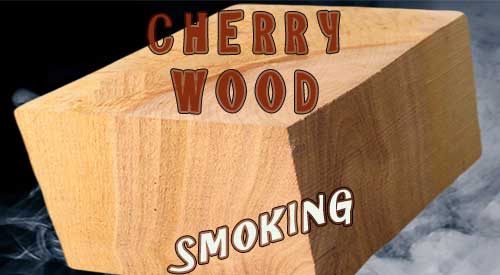Tue 3 Mar 2020
CHERRY WOOD FOR SMOKING WILL IT SWEETEN?
Posted by DrSmokeRead other related stories: Cooking , General Smoking Information , Smoking Tips , Wood Questions
No Comments

WILL CHERRY HARDWOOD SWEETEN EVERYTHING IT TOUCHES?-Without question, Cherry is one of the most popular woods for wood-fired cooking, particularly when it comes to hot smoking using traditional smoking equipment. Despite information SmokinLicious® has provided on this hardwood species (Put a Cherry on It blog & Cherry Wood Question blog), there are still many questions posed and many misunderstandings about this wood. My intention here is to speak on the cherry varieties in North America and ensure that you can make an informed decision when selecting this hardwood for cooking.
Cherry Wood for Smoking- A Few Varieties
I think the one key question is always on the varieties of cherry that people have access to, whether it’s in their own yard or a neighbor’s, or they come across a “firewood” seller along the roadside or an ad online or in print. A good place to start is with a primer on exactly what types of cherry would be common in this scenario and if all of them are suitable for using in cooking.
Black Cherry or Prunus serotine Ehrhart is the most prevalent variety of cherry in North America likely due to its ability to grow in rich bottomlands and moist hillsides as well as drier climates. It is the primary variety used for commercial purposes in the Northeast. Other common names are Wild Black Cherry, Rum Cherry, and Mountain Black Cherry. Black cherry grows from Nova Scotia and New Brunswick west to Southern Quebec and Ontario into Michigan and eastern Minnesota; south to Iowa, extreme eastern Nebraska, Oklahoma, and Texas, then east to central Florida. You can even find small areas in Georgia, Texas, and Alabama.
Let’s be clear, though. There can be great differences in the wood from state to state. Remember, Black Cherry has a high commercial purpose, meaning, it is harvested for cabinetry, paneling, trim work, etc. To make the wood into those products it must be very dry. Keep that in mind when you see prepackaged cherry under the name Black Cherry as the extremely low moisture level will make this hardwood burn more rapidly.
Prunus pensylvanica L.f. with the common names Pin Cherry, Fire Cherry, Bird Cherry, Wild Red Cherry, and Pigeon Cherry is a variety that does not tend to grow as large as the black cherry mainly due to its role as a cover for wasteland and protector of soil beds. Usually once larger trees establish themselves, this cherry variety will be crowded out. It is a wood commonly harvested in New York and Pennsylvania during timber harvesting (SmokinLicious® sources this variety) so it is plentiful in these areas. Because this variety is not as readily found as Black Cherry, it does not have as popular a selling point for the grade lumber to produce the home construction items listed above. If you can locate this variety of cherry, you’ll be pleasantly surprised at its performance as a cooking wood.
Cherry Wood for Smoking- A Common Misconception
Now, briefly, let me touch on the ornamental cherry trees that usually are encountered within neighborhoods and are the trees most people inquire about for trimming and using in their equipment. All cherry trees are part of the genus Prunus. Most of what is sold as ornamental are the Prunus serotine variety. Don’t be fooled into thinking that cherry means anything cooked with that wood will have a cherry-like flavor! Nothing can be further from the truth. The wood itself will have variation in aroma as you may readily find when you burn wood in a fireplace; burn a fireplace frequently enough and you can pick up the aromatics that come from cherry versus maple versus ash, etc.
Flavor from the wood is directly influenced by the other ingredients incorporated and exposed to the heat. It will NOT produce a cherry flavor even if you had plain meat in the cooking chamber with the wood.
In fact, I dare you to find two people who would describe the flavor of a food item cooked over cherry hardwood with the same description.
If you get a hold of an ornamental cherry tree or you take trimmings from a tree, here are my cautions:
- hydrogen cyanide, a poison, is present in the leaves and seed so never burn these when cooking foods as they are very bitter and you increase the potential for a reaction or worse
- many ornamental trees are treated with chemicals to keep them free of insects, larvae, and mold – don’t cook with woods exposed to chemicals as this can contribute to a bitter flavor to foods and increase your risk for an allergic reaction
- using trimmings that are fresh from the tree can produce an acrid smoke due to the high level of water in the wood. It’s best to allow any collected pieces to dry to ensure some of the water has evaporated
There are 18 Prunus varieties available in North America. With a little research and trial and error, you should be able to source a suitable variety for cooking that will give you wonderful wood-fired food memories.

More Related reading on cherry wood for smoking see our other blogs
Additional reading:
-PUT CHERRY HARDWOOD ON IT!
-CHERRY WOOD QUESTION
-COOKING WITH WOOD YOU SHOULDN’T HAVE TO THINK ABOUT YOUR SAFETY
-WHAT WOOD TO USE FOR SMOKING: A PRIMER
SmokinLicious® Products related to this blog topic:
Smoker Logs
Wood Chunks: Double and Single Filet
Wood Chips: Grande Sapore®, Minuto®, & Piccolo®

Dr Smoke- loves cherry wood for smoking, either on its own or mixed with other hardwoods.
